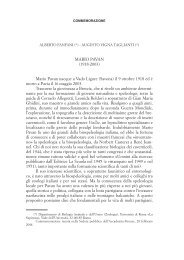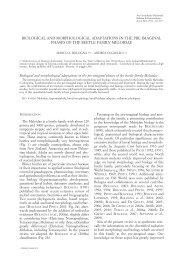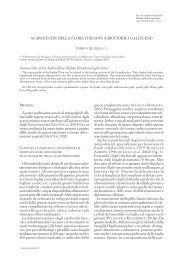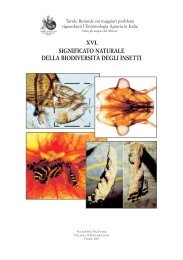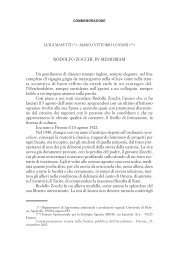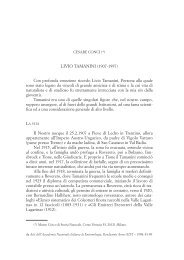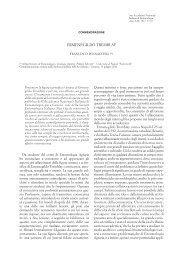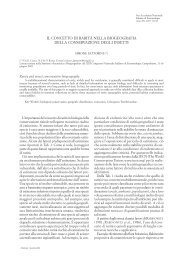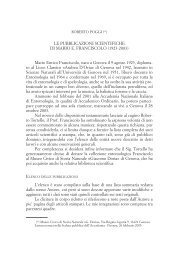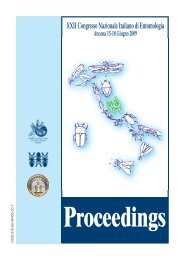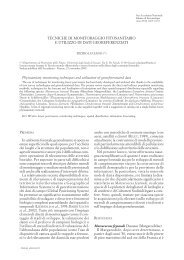GERMINARA G.S., DE CRISTOFARO A., ROTUNDO G. - Accademia ...
GERMINARA G.S., DE CRISTOFARO A., ROTUNDO G. - Accademia ...
GERMINARA G.S., DE CRISTOFARO A., ROTUNDO G. - Accademia ...
Create successful ePaper yourself
Turn your PDF publications into a flip-book with our unique Google optimized e-Paper software.
CONSI<strong>DE</strong>RAZIONI CONCLUSIVE<br />
Gli adulti di D. kuriphilus sono attratti dagli odori<br />
emessi da C. sativa a seguito di un danno meccanico.<br />
Le sostanze del blend attrattivo sono rappresentate<br />
principalmente da composti volatili<br />
della foglia verde oltre che da due terpeni ed un<br />
composto aromatico. Tali composti non sono specifici<br />
del castagno ma sono stati identificati anche<br />
nelle emissioni di altre piante. In natura, il rilascio<br />
di tali sostanze potrebbe avvenire attraverso ferite<br />
e microlesioni causate da fattori biotici e abiotici.<br />
Alcuni GLVs, inoltre, possono essere emessi<br />
in risposta ai cambiamenti fotoperiodici, durante<br />
la transizione dalla fase di luce a quella di buio<br />
(GRAUS et al., 2004; CHAMBERLAIN et al., 2006).<br />
Le antenne degli adulti di D. kuriphilus percepiscono<br />
con diversa selettività e sensibilità i composti<br />
identificati; tuttavia, non tutte le sostanze<br />
EAG attive sono necessarie per l’attrazione, la cui<br />
specificità è determinata dal loro rapporto.<br />
Studi di laboratorio e di campo sono in corso<br />
per individuare una miscela attrattiva ottimale<br />
che, opportunamente formulata, potrebbe essere<br />
utilizzata come semplice e rapido strumento di<br />
monitoraggio e contribuire allo sviluppo di strategie<br />
innovative di controllo del cinipide.<br />
RINGRAZIAMENTI<br />
Ricerca svolta nell’ambito del progetto “Studio<br />
per il controllo ecocompatibile del Cinipide del<br />
castagno” - Contributo n. 28/08 della Regione<br />
Campania. Coordinatore dott. Emilio Guerrieri,<br />
Centro Nazionale delle Ricerche, Istituto per la<br />
Protezione delle Piante, Sezione di Portici.<br />
RIASSUNTO<br />
Si riportano i risultati di studi comportamentali, chimici<br />
ed elettrofisiologici sul ruolo di composti volatili di origine<br />
vegetale nel processo di localizzazione della pianta ospite<br />
in Dryocosmus kuriphilus Yasumatsu. Rami meccanicamente<br />
danneggiati di Castanea sativa Miller, dopo almeno un’ora<br />
dal danno, sono risultati attrattivi per gli adulti del cinipide<br />
al contrario di piantine intere e rami integri o appena danneggiati.<br />
Effetti repellenti sono stati osservati in risposta agli<br />
odori di una pianta non ospite. Dallo spazio di testa della<br />
sorgente odorosa attrattiva sono stati identificati 14 composti<br />
volatili rappresentati principalmente da odori della<br />
foglia verde, due terpeni ed un composto aromatico. Tutte<br />
le sostanze sono percepite dal sistema olfattivo antennale<br />
del cinipide ma con diversa selettività e sensibilità. Studi<br />
comportamentali hanno dimostrato che sebbene una miscela<br />
sintetica, contenente i composti identificati e negli stessi rapporti<br />
presenti nell’emissione della pianta ospite, sia attrattiva<br />
per D. kuriphilus, non tutte le sostanze sono necessarie<br />
per l’attrazione. Tali osservazioni e la natura ubiquitaria dei<br />
– 112 –<br />
composti suggeriscono che la localizzazione dell’ospite in<br />
D. kuriphilus è mediata da un ristretto numero di semiochimici<br />
secondo uno specifico rapporto.<br />
BIBLIOGRAFIA<br />
ABRAHAMSON W.G., HUNTER M.D., MELIKA G., PRICE P.W.,<br />
2003 – Cynipid gall-wasp communities correlate with oak<br />
chemistry. - J. Chem. Ecol., 29: 209-223.<br />
ALLISON S.D., SCHULTZ J.C., 2005 – Biochemical responses<br />
of chestnut oak to a galling cynipid. - J. Chem. Ecol., 31:<br />
151-166.<br />
AGELOPOULOS N., BIRKETT M.A., HICK A.J., HOOPER A.M.,<br />
PICKETT J.A., POW E.M., SMART L.E., SMILEY D.W.M.,<br />
WADHAMS L.J., WOODCOCK C.M., 1999 – Exploiting semiochemicals<br />
in insect control. Pest Sci., 55: 225-235.<br />
BERNAYS E.A., OPPENHEIM S., CHAPMAN R.F., KWON H.,<br />
GOULD F., 2000 – Taste sensitivity of insect herbivores to<br />
deterrents is greater in specialists than in generalists: a behavioural<br />
test of the hypothesis with two closely related caterpillars.<br />
- J. Chem. Ecol., 26: 547-563.<br />
BOLTER C.J., DICKE M., VAN LOON J.J.A., VISSER J.H.,<br />
POSTHUMUS M.A., 1997 – Attraction of Colorado potato<br />
beetle to herbivore-damaged plants during herbivory and<br />
after its termination. - J. Chem. Ecol., 23: 1003-1023.<br />
BRUCE T.J.A., WADHAMS L.J., WOODCOCK C.M., 2005 –<br />
Insect host location: a volatile situation. - Trends Plant Sci.,<br />
10: 269-274.<br />
CHAMBERLAIN K., KHAN Z.R., PICKETT J.A., TOSHOVA T.,<br />
WADHAMS L.J., 2006 – Diel periodicity in the production<br />
of green leaf volatiles by wild and cultivated host plants of<br />
stemborer moths, Chilo partellus and Busseola fusca. - J.<br />
Chem. Ecol., 32: 565-577.<br />
DICKENS J.C., 2000 – Orientation of Colorado potato beetle<br />
to natural and synthetic blends of volatiles emitted by potato<br />
plants. - Agric. For. Entomol., 2: 167-172.<br />
FRASER A.M., MECHABER L.W., HIL<strong>DE</strong>BRAND J.G., 2004 –<br />
Electroantennographic and behavioural responses of the<br />
sphinx moth Manduca sexta to host plant headspace volatiles.<br />
- J. Chem. Ecol., 29: 1813-1833.<br />
<strong>GERMINARA</strong> G.S., <strong>DE</strong> <strong>CRISTOFARO</strong> A., <strong>ROTUNDO</strong> G., 2011 –<br />
Chemical cues for host location by the Chestnut Gall Wasp,<br />
Dryocosmus kuriphilus. - J. Chem. Ecol., 37: 49-56.<br />
<strong>GERMINARA</strong> G.S., <strong>DE</strong> <strong>CRISTOFARO</strong> A., PAPARATTI B., SPERANZA<br />
S., STACCHIOTTI M., <strong>ROTUNDO</strong> G., 2009 – Electro -<br />
antennographic responses of Dryocosmus kuriphilus to<br />
Castanea sativa leaf volatiles. - Acta Hort., 844: 387-394.<br />
GRAUS M., SCHNITZLER J.-P., HANSEL A., COJOCARIU C.,<br />
RENNENBERG H., WISTHALER A., KREUZWIESER J., 2004<br />
– Transient release of oxygenated volatile organic compounds<br />
during lightdark transitions in grey poplar leaves. - Plant<br />
Physiol., 135: 1967-1975.<br />
HOBALLAH M.E., TURLINGS C.J., 2005 – The role of fresh<br />
versus old leaf damage in the attraction of parasitic wasps<br />
to herbivore induced maize volatiles. - J. Chem. Ecol., 31:<br />
2003-2018.<br />
LINN C. JR., NOJIMA S., ROELOFS W., 2005 – Antagonistic<br />
effects of nonhost fruit volatiles on chemically-mediated discrimination<br />
of host fruit by Rhagoletis pomonella flies<br />
infesting apple, hawthorn (Crataegus spp.) and flowering<br />
dogwood (Cornus florida). - Ent. Exp. Appl., 114: 97-105.<br />
LOUGHRIN J.H., POTTER D.A., HAMILTON-KEMP T.R., BYERS<br />
M.E., 1996 – Role of feeding-induced plant volatiles in<br />
aggregative behaviour of the Japanese beetle (Coleoptera:<br />
Scarabaeidae). - Environ. Entomol., 25: 1188-1191.<br />
ROJAS C.J., 1999 – Electrophysiological and behavioural



